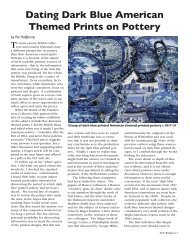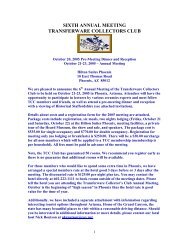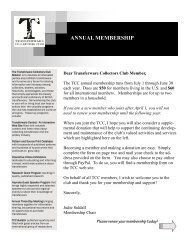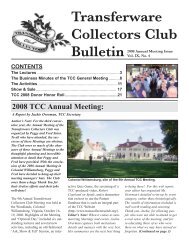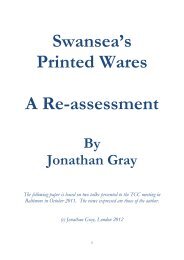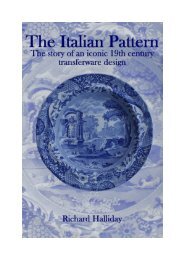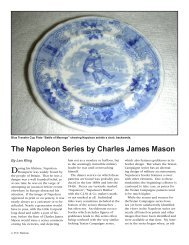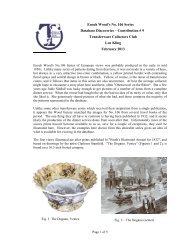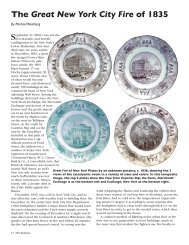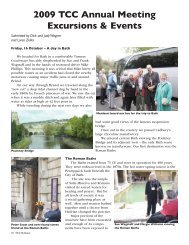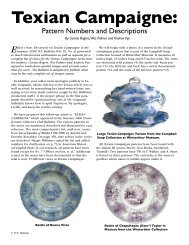download the publication - Transferware Collectors Club
download the publication - Transferware Collectors Club
download the publication - Transferware Collectors Club
You also want an ePaper? Increase the reach of your titles
YUMPU automatically turns print PDFs into web optimized ePapers that Google loves.
In order to illustrate <strong>the</strong> nature of Rothwell’s engraving style we have<br />
illustrated some examples of his later engravings made for magazines and<br />
o<strong>the</strong>r <strong>publication</strong>s as opposed to pottery.<br />
This is not an exhaustive summary of Thomas Rothwell’s engravings but it<br />
does reveal <strong>the</strong> extent of his work and, of course, <strong>the</strong> style of his work,<br />
which, in turn allows us to look at his engravings on pottery in a much<br />
more informed manner.<br />
In order to confirm <strong>the</strong> attribution of <strong>the</strong> early engravings on Swansea<br />
Pottery to Thomas Rothwell <strong>the</strong>re are a number of issues which need to be<br />
examined. Obviously one of <strong>the</strong>se is whe<strong>the</strong>r <strong>the</strong> style of engraving on<br />
Swansea Pottery can be compared favourably with his work previously to<br />
his advent at Swansea and after leaving <strong>the</strong> Pottery.<br />
In order to ascertain whe<strong>the</strong>r this be accurate it is first necessary to<br />
examine what Rothwell’s engraving style was, bearing in mind that as<br />
engraving was <strong>the</strong>n a hand craft, style will develop and change both with<br />
experience and with <strong>the</strong> ultimate destination of <strong>the</strong> final engraving, i.e.<br />
pottery or paper; after all Pottery and paper are two entirely different<br />
media. Much more detail can be utilised on an engraving destined for<br />
paper whereas with pottery less is more and <strong>the</strong>re is also <strong>the</strong> problem of<br />
curved and rounded surfaces. This can be seen by examining <strong>the</strong> large<br />
amount of fine detail on <strong>the</strong> Swansea topographical prints which could<br />
never be done on pottery of <strong>the</strong> time.<br />
Much of Rothwell’s work at Liverpool and Birmingham was of decorative<br />
figures in arcadian landscapes with shepherds and shepherdesses. All one<br />
has to do to confirm this is to see <strong>the</strong> creamware bowl which was in <strong>the</strong><br />
Stretton Collection* This bowl has a black print of Shepherd and a<br />
shepherdess in a rural landscape and again typical of <strong>the</strong> period is <strong>the</strong><br />
black print of Minerva surrounded by clouds and symbols on a teapot in<br />
Liverpool Museum. Ano<strong>the</strong>r teapot in Liverpool Museum with a scene of<br />
‘The Haymakers’ is typical of <strong>the</strong> period. These engravings all engraved<br />
by Thomas Rothwell.<br />
That Thomas Rothwell was conversant with current artistic trends is<br />
shown by <strong>the</strong> mug again in Liverpool Museum signed ‘Rothwell sculpt.’<br />
which bears a black transfer print taken from Benjamin West’s ‘Death of<br />
Wolfe at Quebec’ –a painting which was exhibited at <strong>the</strong> Royal Academy<br />
in 1771. Interestingly Rothwell continued this practice at Swansea. In <strong>the</strong><br />
*English Ceramic Circle Transactions Vol.6 part 3 Plate 150<br />
17



